





How many times have you walked into your garden and found a freshly sprouted seedling laying on its side, that beautiful newly opened rose bloom you went out to cut totally wasted? You've had some unwanted visitors and they're not doing you any favors. I'll tell you about some common pests and how to control them to keep your lawn and garden in great shape.
Number 10/ Tomato Hornworm
A large 3 ½-4 inch green caterpillar which feeds primarily on tomato plants. Populations of these pests vary from location to location and year to year. The tomato hornworm feeds on the leaves and stems and occasionally on the fruit of tomato plants.
It has a number of natural enemies which help to control it. The parasitic wasp lays its eggs on the hornworm. Often this worm is seen with small white projections all over its body. These are cocoons of the wasps. If you see a hornworm with these projections do not kill it. The wasps will hatch and take care of the job for you.
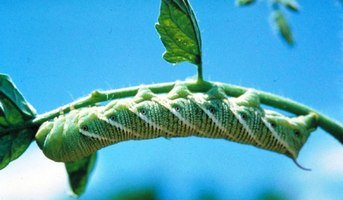
Control
The easiest and least toxic control is hand picking or using a pair of scissors and cutting the worms in half. If the infestations are large, insecticides are in order.
Number 9/Cutworms
Cutworms are the larva of the cutworm moth. They are 1 ½ -2 inches in length and vary from dark to light brown in color. They are found throughout most of North America.
They feed at night usually cutting through young stems at soil level. The worms are usually not seen as they burrow into the soil near the plants they are feeding on during the day.
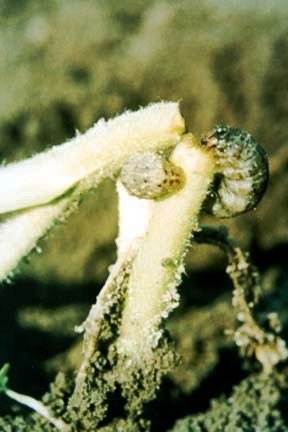
Control
The best control in small home gardens is to place cardboard or metal “collars” into the soil around the plants. The collars pressed 1 -1 ½ inches into the ground form a barrier the cutworms can’t cross.
Number 8/ Flea Beetles
A small insect that can cause big problems. This pest likes to feed on solanaceous crops like eggplant, peppers and tomatoes. They also like cabbage and kale.
The telltale sign of their presence is hundreds of holes in the leaves. The leaves appear like they have been fired at with a shotgun.
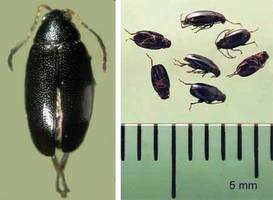
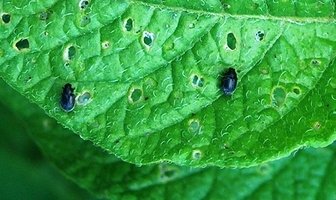
Control
Trap cropping works well to control this pest. A trap crop is a plant that is more attractive to the flea beetle than the crop that you are trying to protect. They are attracted to the trap crop and you treat that crop with an insecticide to kill them. Chinese mustard has worked well as a trap crop for the flea beetle.
For more conventional gardeners products like rotenone and sevin work well.
Number 7/Scale
Scale are insects than have no discernable head or legs, they live under a waxy shell and suck juices from a plant.
They often go unnoticed for long periods giving them time to multiply. They appear like a small fleck on the leaf surface. If left untreated they will suck the life from the host plant.
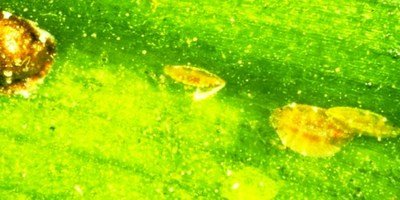

Control
Insecticidal soaps and horticultural oils are effective in treating scale. In severe cases insecticides like sevin and orthene will do the job.
Number 6/Earwigs
This insect has a mean appearance but is harmless to humans and animals. If you care to pick one up you might get a slight pinch but it won’t really hurt you.
They do however like to feed on flowers and if left unchecked can do significant damage.
They are ½- 1 inch in length and range from a light reddish brown to black.
The name earwig is derived from an old European superstition that the insects enter the ears of sleeping humans and bores into the brain. This is totally false.
They may burrow up to six feet into the soil to escape the cold during winter.
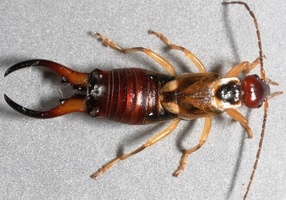
Control
They prefer moist areas. Keep mulches 2-4 inches away from the foundations of buildings. Make sure downspouts carry water 2-3 feet away from buildings. There are many insecticides labeled for earwig control if infestations get out of hand.
Number 5/Japanese Beetles
This pest was first detected in New Jersey around 1916 having been introduced from Japan. It does more damage in the Great Lakes region than any other insect. The adult eats leaves and flowers from more than 300 plants. The larva feeds on plant roots doing significant damage especially in turf grass.
The adult beetle is a brilliant metallic green 3/8-1/2 inch long and 1/4 inch wide.The adult usually emerges in late June or early July, seeks out food plants and begins to feed. As they feed they give off a pheromone (odor) which attracts additional adults. After feeding and mating for a day or 2 the female burrows into the soil and lays her eggs. She then returns and begins to feed and mate again. This cycle is repeated until the female has laid 40-60 eggs. The eggs hatch in 8-14 days and the larvae begin to feed on plant roots.
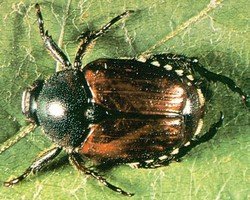
Control
If the infestation is light you can hand pick the adults and dispose of them in a container of soapy water.
There are several insecticides than can control this beetle. Sevin and Orthene are a couple.
Traps are available to catch this insect but I’ve been told by some who have used them that they actually attract more beetles than they catch.
Number 4/Aphids
Aphids are soft-bodied insects that use their piercing sucking mouthparts to feed on plant sap. They usually occur in colonies on the undersides of leaves. The leaves usually turn yellow and wilt due to the loss of sap.
Aphids produce large amounts of a sugary liquid waste called "honeydew". The honeydew that drops from these insects can spot the windows and finish of cars parked under infested trees. Ants like to feed on the honeydew, the presence of ants on or around your plant is a good indicator that you have an Aphid problem.
A fungus called sooty mold can grow on honeydew deposits that accumulate on leaves and branches, turning them black.
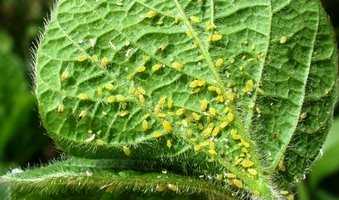
Control
Early detection is the key to reducing aphid infestations. Most products used for aphid control work as contact insecticides. This means that the aphids must be hit directly with spray droplets so that they can be absorbed into the insect's body.
Horticultural oil can also be used to combat aphids. It works by suffocating the insects.
Malathion, Dursban and Orthene are also effective against aphids. Follow the instructions on the label.
Beneficial insects, such as lady beetles and lacewings, will begin to appear on plants with moderate to heavy aphid infestations. They may eat large numbers of aphids but the reproductive capability of aphids is so great that the impact of the natural enemies may not be enough keep these insects at or below acceptable levels.
Number 3/ Spider Mites
Spider mites are prevalent across North America. They feed on the plant by sucking sap from the leaves leaving small light flecks. They also produce webbing most noticeable when there are high populations of this pest.
They hatch from eggs that have been laid on the undersides of leaves. After they hatch it takes only about a week to become fully grown. Usually most of their activity occurs during the warmer months.
One reason that spider mites become a problem it that most insecticides kill their natural enemies causing them to multiply rapidly.
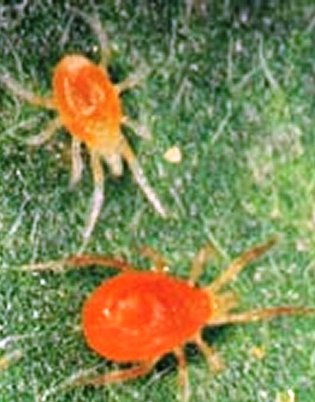
Control
A healthy plant is the best defense against spider mites. Keep plants well watered and fertilized to ensure vigor.
A good rinsing with a forceful stream of water will knock many of the mites to the ground and kill them. Do this to susceptible plants on a regular basis.
Most insecticides are not effective against mites. You need to use a miticide. These products do not kill the mite’s eggs so they need to be reapplied in 10-14 days.
Number 2/White Grubs
White grubs are the C-shaped larvae of a large group of beetles called scarabs. The most important species are: Japanese beetle, May or June beetles, northern and southern masked chafers, and European chafer.
The pests are found throughout most of the US east of the Mississippi.
They eat plant roots so the damage first appears to be drought related. In turf grass the color gradually turns to a light green then brown. Usually in areas where grubs are present predators like moles and skunks will dig up the soil in search of grubs to feed on.
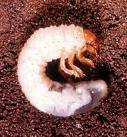
Control
Several strains of bacterium, Bacillus popilliae marketed as Milky Spore has shown to be effective against grubs.
There are several chemical controls effective to combat grubs; the key to their success is that they need to be applied when the grubs are in the feeding stage. This occurs at different times throughout the country. Check with a reputable garden center for the appropriate time to apply these products.
Number 1/ Slugs
Slugs simply put are a snail without a shell. They live on and under ground and have a huge appetite for a large range of plants. I would venture to say that anyone who grows hostas has had a slug problem at one time or another.
They range in size from 1/2 4 inch to over 7 inches. I came across one last summer that had to be a good 6-7 inches in length.
They are voracious feeders and leave telltale holes in the leaves of mainly shade plants such as hostas.
They like to live in cool, damp, dark areas; under rocks, boards and heavily mulched areas.
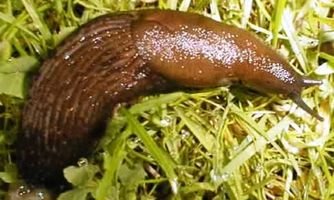
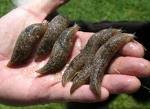
Control
Trapping the use of beer or any fermenting food (such as a mixture of sugar, yeast and water) put in cups in the ground will surprise you with the number of slugs that fall into the cups and drown.
Hand Picking You can place a damp section of newspaper in areas where slugs are present late in the evening. The next morning go out and turn the newspaper over, you should find slugs on the underside of the paper. They may be disposed of in a container of soapy water.
Slug Baits Slug baits are probably the most consistent and efficient method of slug control. Several commercially available baits or pellets are available which contain a poison that kills snails and slugs. Since these poisons may be toxic to pets, fish and humans, use carefully as directed on the label.
References and Photos:
University of Kentucky Entomolgy Dept.
University of Illnois Extension
University of Vermont Extension
North Carolina State University
Ohio State University
Copyright © www.100flowers.win Botanic Garden All Rights Reserved